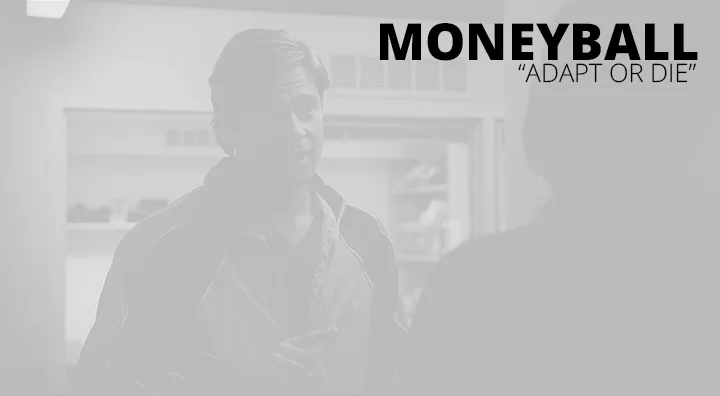This is the fourth article in our Moneyball series. We recommended reading the previous three posts in the series for context.
- Article #1: "Moneyball: The Digital Marketing Story for Banks and Credit Unions"
- Article #2: "Moneyball: What's the Problem with Bank and Credit Union Digital Marketing?"
- Article #3: "Moneyball: What's the Solution for Bank and Credit Union Digital Marketing?"
Conflict is a necessary component of a story.
It is the force that propels the narrative forward.
And it is the source of character transformation.
For Billy Beane, the general manager of the Oakland Athletics and protagonist of the movie Moneyball, the central conflict he must overcome is the rebuilding of his team’s roster with a limited payroll.
However, this is not the sole obstacle that Billy will encounter on his journey. Like any well-told narrative, numerous other trials and tribulations will arise, testing the resolve of our protagonist.
“Who’s That?”
One protracted conflict is between Billy and Grady Fuson, the antagonist lead scout who believes the only way to correctly rebuild the team is the traditional method of player evaluation. This process involves assessing and selecting players based on intangible characteristics that “only baseball people understand.”
In previous scenes, the tension simmers between these two characters as they each stake their respective positions as to how the team should fix the problem.
The conflict continues to brew in the following scene.
Billy enlists the help of Peter Brand, an outsider to not only the organization but baseball as a whole. Peter is tasked with implementing a new methodology designed specifically to identify affordable, valuable players for the A’s roster. This systemic process is rooted in data and analytics, which is a departure from the traditional method.
A short time later, the scouting team assembles to discuss their own findings with Billy.
However, Billy outlines a different vision for the organization.


Let's break the scene down.
Even as Billy suggests the acquisition of Jeremy Giambi, several of the scouts immediately pounce on several of the perceived flaws of the player.
“He’s getting a little thick around the waist,” one scout says.
Another scout worriedly makes comments about the overall character of Giambi.
“Well, his on-base percentage is all we’re looking at now,” Billy interrupts. “And Jeremy gets on base an awful lot for a guy who only costs $285,000.”
While we cut this scene down in the interest of time, Billy further recommends a few other players (David Justice and Scott Hatteberg), to which Grady frustratingly refers to them as “defective players.”
The chasm between the scouting team and Billy is evident in this scene, as the scouts do not understand the most important metric: on base percentage. This stat measures how often a batter reaches base.
Instead, the scout teaming continues to rely on what’s familiar to them in their method of evaluating a player's potential.
This is the perfect manifestation of being fearful of the unknown, a topic which we will explore in a moment.
The Knowledge Gap
We have observed a similar chasm in the financial services industry when it comes to peoples’ understanding of digital marketing.
In our annual State of Digital Growth Report, we have consistently found that bank and credit union marketers are keenly aware of the lack of digital marketing skills in their organizations.
This stat is validated by additional internal data at Digital Growth Institute.
As part of our Digital Growth Blueprint engagements, our clients participate in a 75-question digital skills assessment. During this evaluation, we assess our clients' marketing departments' competency on different digital marketing subjects, including consumer journeys, user experience, search marketing, digital advertising, and data and analytics.
The average score for our clients: 63 out of a possible 100.
It's no surprise that when asking bank and credit union executives to share their thoughts and feelings about the topic of digital marketing, there is a pattern of frustration and concern.
Here are a few direct quotes from clients we've worked with:
- "I feel so overwhelmed and confused."
- “We don’t know what we don’t know.”
- “Where do we even begin with digital marketing?”
- “How much should we be spending?”
- “Do we have the right people in place?”
- “I’m sure glad I’m retiring in two years.”
However, this knowledge gap is not unique to just the financial services industry and is reflective across many verticals. Here are some findings from Capgemini Consulting.
A Lack of Trust
While these metrics are indeed eye-opening, what’s more pressing is that there is a chasm between CEOs and marketers. A study from The Fournaise Group a few years back found that an 80% of CEOs simply don’t trust marketing.
What is the root cause of this lack of trust? A majority of CEOs responded that marketers lose sight of their primary function within the organization: generate demand (leads) in a quantifiable and measurable way.
The manner in which marketing is viewed within the organization is timid at best. This perspective is echoed internally with some of our own clients:
- "Marketing is a cost center."
- "Marketing is viewed as an in-house FedEx Kinkos."
- "All they do in marketing is play with paint and crayons."
- "There's a lack of trust for our marketing team."
This lack of trust might come from your CEO.
Or from your board of directors.
Or it may come from someone on your executive team.
Regardless of their position in your bank or credit union, your function as a marketer and advocate for digital marketing is simple: move beyond vanity metrics and prove to those outside the department that marketing is a profit center.
This takes time. And it's something we'll share in greater detail in our next Moneyball article.
However, it's through this new perspective you can give the skeptics the vision they need to move confidently forward to build a business model around digital and mobile and away from the current business model built around branches and broadcast.
How Do You Close This Gap?
As I mentioned before, people like Grady fear the unknown.
While some may thrive because of this uncertainty, many individuals become paralyzed when facing this digital frontier. This is especially true in financial services because digital a departure from the physical structures and processes banks and credit unions have built in the past.
How do you, or help others, overcome this crippling fear?
In short, it comes through continuous ongoing education because people fear what they don't understand.
In fact, we observed this fear of the unknown firsthand with a client who was well aware of the changes they needed to make to their marketing and sales processes. The issue, though, is the client just didn't know where to start.
Their journey began with humble beginnings as the financial institution enrolled their marketing director in one of our Digital Growth Training Programs.
During this training program, the marketing director gained new insight and perspective into the opportunities that digital marketing could provide to help align their marketing and sales departments.
A few weeks after returning home, the marketing director emailed us to share her immediate success as she went home inspired, ready to put into action what she had learned.
The executive team was impressed with the knowledge and insights brought back, asking the marketing director to continue to lead the bank on their digital marketing journey.
After some time had passed, the marketing director requested additional guidance through our Digital Growth Blueprint. After reviewing the details of the engagement, she was excited to get started.
But before the engagement could be finalized, the marketing director ran into resistance from her executive team. They had several questions and some hesitancy she had to first address.
Through our guidance, we provided her with the resources she needed to help her overcome her colleagues’ fear of the digital unknown. And once their concerns were alleviated, she was able to continue her journey as she used her Digital Growth Blueprint as a framework and roadmap for future digital marketing initiatives.
And now a few years later, the plan this marketing director implemented has completely transformed and revitalized not only the marketing and sales departments but the entire organization as a whole.
“You Don’t Put a Team Together With a Computer”
Back to Moneyball.
As the narrative advances, the friction between the protagonist and antagonist reaches a boiling point. Feeling like his industry expertise is being cast aside for an unproven methodology, Grady bluntly voices his concerns.


Despite Grady’s objection and resistance to see the opportunity a new methodology and process could bring to the team, Billy beautifully sums up one of the key themes of the movie.
“Adapt or die.”
Evaluating Your Staff
Even if you have yet to see the movie, the fate of the character of Grady should not shock you.
Yes, Grady does get fired.
And while this not a popular subject to discuss, we believe it is necessary to address.
We recommend you complete a serious review of your bank’s or credit union’s staff if you venture down this path of digital growth.
When we deliver a Digital Growth Blueprint to a bank or credit union, we typically make one of four recommendations regarding their marketing and sales staff, especially when we feel there is a significant knowledge gap with internal resources.
Here are our four recommendations:
- You can train staff on an ongoing basis to bring them up to speed with the best digital marketing and sales practices.
- You can hire staff to bridge the knowledge and talent gap as needed.
- You can fire staff who are no longer a good fit for the organization.
- You can outsource in the short-term with the intent to hire and train in the long-term.
Sometimes, People Just Don’t Understand
Grady personifies the mindset of the traditional baseball scout, so hardened in his own methodology that he cannot see another solution to the central problem of the story.
He just doesn't understand the need for this shift.
And when discussing the need to transform your business model around digital and mobile delivery, you may find that not everyone shares the same perspective.
There are three Digital Growth Characters that you need to be made aware of when you embark on your digital growth journey:
Agents: Those willing to embrace the opportunities that digital marketing and digital growth provide. Example: Billy Beane, Peter Brand.
Neutrals: Those who are ambivalent to a digital growth strategy and are neither full invested nor overly skeptical. Example: the Oakland A's ownership.
Resistors: Those who are openly cynical about digital growth transition. Example: Grady Fusion, the Oakland A's scouting team.
It is necessary to understand these different characters because the success of your digital growth journey hinges on what happens next.
When undergoing digital growth transformation, your staff will unconsciously categorize themselves into the above three groups. Some will react positively to the proposed changes (agents), others will respond indifferently (neutrals), and some will openly display contempt and skepticism (resistors).
Trust me: we've seen this narrative play out before, regardless of asset size.
While agents may want to spend time converting the non-believers of the resistor group, we believe it's more advantageous to appeal to the group of the neutrals.
Individuals in this party can be swayed either way, and it's up to you to communicate the vision of the opportunities digital marketing and digital growth provide.
This is not to say that resistors ultimately cannot be enlightened, but the amount of time, effort, and resources required to appeal to this group makes it significantly more challenging. Besides, some resistors may be so entrenched in their perspective that they may never change.
However, at the end of the day, this is about the future of the bank or credit union, which can be summed up with these three words from Moneyball.
Adapt or die.
On Deck >>
"Perfecting the Process." Like the Moneyball system implemented by Billy Beane, digital marketing is also a process that can be continuously optimized and improved over time.
This article was originally published on November 9, 2017. All content © 2024 by Digital Growth Institute and may not be reproduced by any means without permission.





